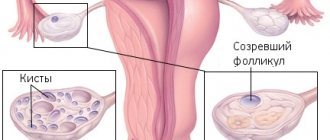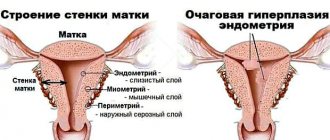Types of pathology
Ovarian hyperplasia is classified according to the volume and area of the lesion. In this case, changes in tissue can be observed in one or two ovaries at once.
Depending on the type of disorder in the gonads, stromal or endometrioid hyperplasia can be observed. Let's look at each of these types of disease in more detail.
Ovarian endometrial hyperplasia
Endometriosis is usually diagnosed in women aged 25-35 years, however, it can sometimes develop during menopause. In this condition, there is a change in the lining of the uterus. It goes beyond the organs and spreads to areas unusual for it.
The definitive causes of this type of disease are not fully understood, however, it is believed that immune and hormonal imbalances most influence its development.
Attention! Women who have previously had an abortion, had a complicated birth, or used intrauterine devices are at increased risk for endometriosis.
Hyperplasia of the right ovary
This type of disease is the most common. This is justified by the fact that it is in the right ovary that blood circulation is increased due to the nearby artery.
Women over 40 years of age are most susceptible to this damage. This is due, first of all, to hormonal fluctuations, as well as circulatory disorders in the pelvic organs.
A characteristic feature of this pathology is the risk of bleeding during menopause. Less commonly, prolonged inflammation in the uterus and other pelvic organs leads to pathology.
Important! Severe pain, discharge of blood from the vagina outside of menstruation, as well as a high temperature against this background should be a good reason to urgently consult a doctor. Self-medicating in this condition is extremely dangerous.
Left ovarian hyperplasia
Proliferation of tissue of the left ovary usually occurs due to dysfunction of the hormonal glands. In this condition, a woman may experience severe pain in the lower abdomen, weakness, weight loss, and discomfort during sexual intercourse.
In this case, pathological tissue proliferation can be diagnosed after a complete examination, including blood tests for hormone levels.
Ovarian stromal hyperplasia
Ovarian stromal hyperplasia is characterized by the proliferation of ovarian tissue. This condition leads to hyperplastic changes in cells. Many doctors believe that the disease can only develop during menopause in women, when the level of hormones is disrupted sharply and almost irrevocably.
Due to this pathology, more estrogen begins to be produced during orgasm, which leads to a malfunction of the endocrine system. The consequence of this process is an increase in body weight, impaired digestion of glucose, as well as problems with blood pressure.
It should be noted that the volume of the organ may increase with stromal hyperplasia; however, this is observed only in advanced stages of the pathology. During the initial diagnosis, the structure of the organ will be changed, but the follicles will remain unchanged.
To distinguish this type of disease from a malignant tumor, it is important to conduct a number of differential studies.
Ovarian hyperplasia, what it is, how it begins and is treated. Symptoms of hyperplasia
Ovarian hyperplasia is a gynecological pathology in which the stroma and endometrium increase, which in turn provokes swelling of the ovary. The proliferation of stromal glands occurs simultaneously with luteinization, proliferation, or hyperproduction of androgens.
There are several methods for diagnosing and treating this disease. The pathology can be congenital or develop as a result of hormonal imbalances. Inaction in the event of such a deviation can trigger tecomatosis, a precancerous process.
The main symptom of tecomatosis is a violation of the release of certain hormones.
Medical indications
Hyperplasia occurs in one of several hormonal glands. Often such pathological conditions are accompanied by the presence of concomitant tumors of the uterus or ovaries. Women of all ages are susceptible to the disease. The disease is especially dangerous before and after menopause. It provokes disruptions in the functioning of the endocrine system, disrupting the functions of the endometrium.
Scientists have not yet established the exact cause of the development of the disease in question. But it is known that the factors causing pathology are divided into 2 groups:
- Congenital ovarian hyperplasia - manifests itself in the form of genetically inherited abnormalities. These include various tumors of the genital organs or mammary glands, disorders during puberty or hormonal imbalances.
- Acquired hyperplasia can be caused by gynecological diseases or inflammatory processes in the genital organs. Various types of surgical interventions or procedures related to the reproductive organs can serve as causative agents of the disease. Among the gynecological diseases that provoke hyperplasia are endometriosis, fibroids, and mastopathy.
Please note: In rare cases, ovarian hyperplasia may be a complication of diseases of the liver, endocrine or cardiovascular system. People with obesity, diabetes, hyperglycemia and arterial hypertension are at risk. Excessive secretion of estrogen, which contributes to the normal functioning of the female genital organs, provokes the development of hyperplasia.
Risk factors
Experts include additional risk factors that provoke the disease in question:
- retrograde menstruation - during menstruation, blood clots penetrate the abdominal cavity, attaching to the walls of the uterus and forming new tissue. “Unhealthy” blood causes inflammation and bruising. The changes that occur in the body during retrograde menstruation create favorable conditions for the development of hyperplasia;
- metaplasia - during menstruation, tissues are not fixed inside. This provokes metamorphosis in the structure of the endometrium. The reason for this may be a malfunction of the immune system (in case of damage to the fallopian tubes).
We recommend you learn: How serosocele of the left ovary develops
Principles of disease classification
Signs of hyperplasia can lead to infertility. Acid follicles are the main indicator of this disease. External symptoms of the pathology are presented in the form of irregular periods, excess weight and increased hair growth. Bleeding before or after the menstrual period is also a sign of hyperplasia.
Tissues rejected during menstruation end up in the abdominal cavity. A similar phenomenon can be observed in the body of a healthy woman. But under the influence of the above factors, it can lead to the development of hyperplasia. In this case, foci of inflammation and cysts form on the glands.
The disease is divided into several types depending on the symptoms and treatment regimen:
- Glandular cystic hyperplasia of the ovarian endometrium - pathology is determined by the presence of tissue similar to the endometrium on the surface of the glands. They are bilateral and are accompanied by inflammation and the appearance of adhesions in the pelvis.
- Cystic ovarian endometrial hyperplasia - this disease is not a tumor, but it starts the tumor process. With such a deviation, the resulting endometrial cysts can reach enormous sizes, which leads to the growth of glands. A specific sign of this disease is the absence of symptoms. You can detect cystic hyperplasia of the ovarian endometrium at an appointment with a gynecologist. Histological examination allows us to study endometrial tissue.
Types of pathology
Hyperplasia of the right ovary is a common phenomenon. Experts associate this pathology with excessive blood flow to the right ovary. The disease may appear as a result of a prolonged inflammatory process, abnormalities in the blood supply to the pelvis or hormonal imbalances. Representatives of the fairer sex after the age of 40 are susceptible to hyperplasia of the right ovary.
Hyperplasia of the left ovary is a rare deviation that may be evidence of dysfunction of the hormonal glands or the pelvis.
The main reason for the manifestation of pathology in this form is a lack or excess of certain hormones, which leads to unnatural growth of the endometrium and stroma. The patient experiences pain.
Symptoms such as malaise, pain in the lower abdomen, and discomfort during sexual intercourse are common. Competent diagnosis will allow you to develop a suitable treatment regimen.
Ovarian stromal hyperplasia is a pathology characterized by proliferation of glandular stroma and increased production of androgens. The disease manifests itself in the premenopausal period. Pathology can be of estrogenic or androgenic origin. It provokes hypertension, excess weight, and disturbances in the processing of glucose.
We recommend you find out: What is oophoritis of the ovary
Diagnosis of the disease
Women often do not attach importance to bleeding that appears before or after menstruation. During menopause, the symptoms of the disease are more pronounced. Heavy bleeding begins and severe pain appears. Anemia may develop.
Diagnosis of the disease includes:
- Ultrasound confirms or denies the presence of hyperplasia and detects concomitant pathologies of the pelvis.
- Histological and cytological examination - monitors morphological changes in the glands and hyperplastic epithelium.
- Hormone study - determines the level of progesterone and estrogen
When diagnosing, it is important to determine the presence of pathology and its form. Ovarian stromal hyperplasia rarely causes enlargement of the glands. If they increase slightly, yellow clots appear. Microscopic examination of stromal cells reveals the presence of oxidative enzymes responsible for the reproduction of stereogenic hormones.
The following studies are prescribed to help determine the treatment method:
- Differential examination - diagnoses stromal hyperplasia, the presence of sarcoma and other oncological diseases.
- Laparoscopic biopsy - determines testosterone levels and the state of general hormonal levels.
- Histological examination of hyperplasia in the stromal form determines the amount of luteinized lipids and reveals the presence of atretic follicles.
Treatment methods
Treatment methods for ovarian hyperplasia depend on the degree of damage and the morphological state of the tissue.
At the first stage, conservative treatment is used (anti-inflammatory drugs, dehydration procedures).
Pharmaceutical treatment includes hormonal drugs - combined oral contraceptives, the action of which is aimed at adjusting hormonal levels.
Synthetic progesterone substitutes are indicated for women at any age, regardless of the form and complexity of the disease. The duration of treatment is 6 months.
Side effects include bleeding and pain in the affected area.
Medicines Duphaston and Norkolut should be taken on the recommendation of a specialist. More often, such drugs are used in combination with the intrauterine hormonal device Maren. Gonadotropin releasing hormone agonists stop the production of certain hormones, stabilizing the hormonal balance. Such drugs are easy to use.
Surgical treatment
If drug therapy does not have the desired effect, surgical intervention is used. Laparoscopic electrocoagulation is a procedure that involves burning the ovary at several points using an electrode.
If such manipulation is ineffective, oophorectomy is used - removal of glands, which prevents the formation of malignant tumors.
Sometimes a combination treatment is prescribed, which includes surgical and restorative hormonal therapy.
Prevention of ovarian hyperplasia involves monitoring hormonal balance. Stressful situations should be avoided and weight should be controlled. It is necessary to pay attention to the course of the menstrual cycle. If deviations occur, it is recommended to consult a gynecologist.
Please note: To prevent the disease, young women are recommended to take hormonal medications, as they reduce the likelihood of hyperplasia. Prediction of pathology is influenced by factors such as age, chronic diseases, form and neglect of hyperplasia.
When the disease is detected at an early stage, it can be completely cured, and prevention will help prevent recurrence. Detection of hyperplasia at a late stage, when it develops into a cystic or malignant formation, can lead to amputation of the glands. Hyperplasia without the necessary treatment can cause serious harm to women's health.
Source: https://ProYaichniki.ru/zabolevaniya/giperplaziya-yaichnikov.html
Causes of pathology
The onset of menopause is always a great stress for the female body, since in this state diseases that were previously asymptomatic become more active. Ovarian hyperplasia develops for the following reasons:
- Hormonal imbalance. During menopause, ovarian function decreases, so the body experiences a disruption in the production of a number of hormones.
- Taking contraceptive medications.
- Diseases of the endocrine system. This could be diabetes or thyroid dysfunction, which can affect hormone production.
- Genetic predisposition to the disease.
- Autoimmune disorders.
- Frequent trauma to the uterus, which occurs during operations and abortions. Such procedures reduce the body's perception of the effect of progesterone and cause accelerated cell division.
Ovarian hyperplasia - signs and diagnosis, manifestation, types, methods of therapy and prevention
Endometrial hyperplasia is a benign process along with adenomyosis and fibroids. The term “hyperplasia” means excessive growth of the internal functional layer of the uterus, which is transformed under the influence of hormones, creating favorable conditions for pregnancy.
If fertilization does not occur, the layer is rejected and menstruation occurs. Long-term maintenance of the same level of estrogen leads to pronounced stimulation of the endometrium. It consists of glandular tissue (performing a specific function in each organ) and stroma (the binding component of connective tissue).
As a result, the glandular tissue grows greatly. When menstruation occurs, its rejection is accompanied by heavy bleeding. In some cases, long-term hyperplasia may not resolve on its own, but may degenerate into a malignant process. Hyperplasia in this case will be considered a precancerous disease.
Without proper control and treatment, neglected processes can have fatal consequences.
As already noted, the main reason for the development of hyperplastic processes in the endometrium is stimulation of the epithelium by estrogen. There may be an increase in tissue susceptibility to their action, as well as a decrease in progesterone levels.
The source of estrogens for the development of hyperplasia in older age is fattening tissue during obesity (as an additional organ that synthesizes estrone), high levels of follicle-stimulating hormone and ovarian hyperstimulation due to reproductive function fading with age.
In young girls, due to the immaturity of the regulatory systems, the follicles (the main functioning units of the ovary) sometimes take significantly longer to mature and transform into an egg and the level of hormones does not drop quickly enough.
In addition, there are primary diseases that can lead to pathological levels of estrogen: hormonally active tumors of any organs, an increase in functional ovarian tissue during drug stimulation of ovulation, and previous inflammation of the ovaries.
Hyperplastic processes are divided into benign: polyp and, in fact, hyperplasia and malignant (atypical) hyperplasia.
The main symptom of such changes will be uterine bleeding (menorrhagia or metrorrhagia), corresponding to the menstrual cycle or independent of it.
The cause of such bleeding is the rejection of hyperplastic areas after their destruction, thrombosis of blood vessels and other changes.
When such changes are detected, the establishment and verification of the diagnosis is carried out by a gynecologist together with a morphologist and oncologist; in the absence of a reliable diagnosis, consultation with a therapist and an endocrinologist may be required.
Primary studies necessarily include a comprehensive assessment of medical history, determination of hormonal status, general blood test, coagulogram and other studies for differential diagnosis with blood diseases.
The gold standard for diagnosis is to obtain material from the altered mucosa and study it under a microscope. To obtain material, you can perform hysteroscopy and separate diagnostic curettage of the uterine cavity on days 5-7 of the menstrual cycle or aspiration biopsy.
Ultrasound of the uterus allows you to indirectly assess the size and structure of the endometrium. Under normal conditions, the thickness of the endometrium grows gradually after menstruation to 3-4 mm in the first 10 days, and increases to 12-15 mm on the eve of the next menstruation.
If these sizes in a girl of reproductive age are larger than those listed, then it is worth continuing the examination. In postmenopausal women, the normal size of the endometrium is no more than 5 mm.
Treatment depends on the age of the patient and the type of hyperplastic process. When a girl of reproductive age is admitted with uterine bleeding against the background of hyperplasia, hormonal hemostasis is performed (the ability to contract bleeding vessels and change the mucous membrane under the influence of estrogen-gestagen drugs is used).
If an older woman is in menopause, then diagnostic curettage of the uterine cavity is used as a method of stopping bleeding. In fact, to eliminate and subsequently prevent hyperplasia, medicinal substances that inhibit ovarian function and lead to endometrial atrophy are widely used.
Treatment control is carried out after 4-6 months by repeated curettage of the uterine cavity and morphological study of the resulting material.
If the disease is combined with another pathology of the uterus, cannot be treated and often recurs, you need to think about surgical treatment. Various operations are performed to remove the endometrium itself or remove the uterus and appendages. The methods will depend on the age, possible preferences of the woman and the views of the doctor.
Causes
Hyperestrogenism is considered, rather, not a cause, but a trigger in the development of the disease. The following factors can cause it:
- age-related hormonal changes in the body (in adolescence or during menopause);
- some ovarian diseases that provoke increased secretion of estrogen;
- functional disorder of the adrenal glands;
- taking hormonal medications (for example, birth control) without a doctor’s prescription;
- genetic predisposition;
- endocrine system disorders (diabetes mellitus, thyroid problems);
- frequent abortions, curettage.
Symptoms and types of disease
The main manifestation of developing endometrial hyperplasia is disruption of the regular menstrual cycle:
- break between menstruation up to 3 months;
- subsequent heavy bleeding that lasts 7 days or longer.
Against the background of these symptoms, other disorders in the body are often observed:
- overweight;
- decreased metabolism;
- frequent inflammatory processes in the genital organs;
- increased insulin levels in the blood;
- infertility or miscarriages.
Modern gynecology identifies three main forms of endometrial hyperplasia:
- glandular-cystic;
- focal (polyps);
- atypical (the most complex and dangerous type of disease that can develop into a cancerous tumor).
Diagnostics
For any uncharacteristic manifestations during the menstrual cycle, you should immediately visit a gynecologist. Tell your doctor about the symptoms you notice. Be sure to check:
- what medications you have taken in recent months;
- whether there were (including uncompleted: abortions, miscarriages);
- how the menstrual cycle usually goes (regularity, number of days, amount of discharge).
Laboratory and hardware diagnostics include:
- hormonal blood test;
- transvaginal ultrasound (usually performed in the first week of the cycle, but with prolonged bleeding - on any day) - to determine the thickness of the endometrium, which in this disease differs from the healthy state of the mucosa;
- hysteroscopy with separate diagnostic curettage of the uterine mucosa - is performed for any form of hyperplasia, provides the most complete information and is both a diagnostic method and a preliminary stage of treatment.
If necessary, the doctor may prescribe additional examinations and differential diagnostics to exclude other diseases with similar symptoms.
FAQ
Is it possible to get pregnant with endometrial hyperplasia?
No. The altered endometrial layer does not allow the fertilized egg to implant normally in the uterus, which leads to early miscarriage and the inability to bear a fetus. Before conceiving and planning a pregnancy, it is imperative to cure the disease.
Are there traditional methods of treatment?
No. Self-treatment, at best, will not give any effect, but can provoke complications.
Is curettage dangerous for a nulliparous woman?
Separate diagnostic curettage will allow the mucous membrane to renew itself, as after menstruation. This, on the contrary, will increase the chance of successful conception.
Can hyperplasia go away on its own over time?
No. And hoping for this is not only useless, but also dangerous. Over time, such a disorder can develop to a precancerous state, when drug treatment becomes impossible and surgical removal of the uterus (possibly along with the tubes and ovaries) is required. At the first suspicion of hyperplasia, immediately contact a specialist.
Ovarian pain with hyperplasia: symptoms
Due to the fact that hyperplasia is based on a malfunction in the hormonal system, the signs of pathology can be very different. Most often, the disease manifests itself in the form of the following disorders:
- voice change;
- cyst formation in the uterus;
- prone to acne;
- profuse bleeding;
- decreased libido;
- discomfort during sex;
- Irregular menstruation (especially during menopause).
Important! In some cases, the disease does not manifest itself at all, so a woman learns about its existence only after undergoing tests and an ultrasound scan.
Diagnosis of ovarian hyperplasia in women
Due to the absence of pronounced symptoms, the diagnosis of ovarian hyperplasia requires a number of differential studies. The following activities are traditionally used:
- Ultrasound examination of the pelvic organs.
- Blood test for hormones.
- General blood tests.
- Biopsy or cytological examination.
It is also mandatory to undergo an examination and consultation with a gynecologist, surgeon, therapist and endocrinologist.
Diagnostics
Diagnostic measures include a set of studies:
- Examination in a gynecological chair. Upon palpation, an increase in the size of the organ is detected.
- In order not to confuse hyperplasia with inflammatory diseases, in which there is also an enlargement of the gland, an ultrasound is performed, which determines the presence of pathology.
- To determine whether the process is benign or malignant, a biopsy is performed with further cytological and histological examination.
These diagnostic methods are sufficient to make a diagnosis. The main difficulty lies in differentiating hyperplasia from other tumor-like processes of the pelvic organs.
Treatment
Traditional treatment for this disease is medication. It is aimed at eliminating the inflammatory process and normalizing a woman’s hormonal levels. For this, the following groups of drugs are usually used:
- progesterone analogues;
- drugs to restore hormonal levels;
- means for normalizing endometrial functions (Duphaston).
Specific drugs and their dosage are selected for each patient separately, depending on the type, degree of neglect and cause of the disease.
If drug therapy does not bring improvement, the woman is prescribed surgery (cauterization of tissue with an electrode or partial removal of the affected area of the organ).
Types and treatment of ovarian hyperplasia
Ovarian hyperplasia is the proliferation of endometrial and stromal cells, which leads to an increase in the size of the organ and hormonal imbalance. It is diagnosed at any age, but women of pre-menopausal and climatic age are at risk. Next, we will consider the causes and symptoms of the disease, as well as methods of diagnosis and treatment.
The disease often occurs under changes in the ratio of female and male sex hormones (androgens), with the predominance of the latter. In some cases, it indicates a pretumor process or accompanies the formation of a tumor.
Hyperplasia is a benign pathology and is treatable.
Reasons for the development of the pathological process
Based on the time of occurrence, the causes of ovarian hyperplasia can be divided into congenital and acquired. Congenital disorders include embryonic developmental disorders, hereditary predisposition (cases of hyperplasia in the family, tumors of the ovaries and/or mammary glands), as well as hormonal imbalances during puberty.
Acquired occurrence factors include cases of diseases of the abdominal cavity and pelvic organs.
Thus, women with a history of chronic adnexitis, hormone-dependent disorders (mastopathy, endometriosis of the uterus and ovaries), cysts, and those who have undergone surgery in the past in this area are at risk.
The connection between hyperplasia and a history of diseases such as diabetes mellitus, pathologies of the endocrine system (hypo- and hyperthyroidism, thyrotoxicosis, Hashimoto’s disease), as well as cardiovascular disorders has been proven and scientifically substantiated. Since these diseases can lead to increased production of estrogen in the body, then, as a consequence, ovarian hyperplasia occurs.
Symptoms of ovarian hyperplasia
Clinical manifestations are caused by hormonal imbalance, so there are no specific symptoms of the disease. All signs manifest themselves in the form of disturbances in the production of hormones: disruptions of the menstrual cycle, early or late onset of menstruation during puberty, bleeding in the middle of the cycle, spotting, small cystic ovaries.
Also, due to hormonal imbalance, acne, excess body hair growth, deepening of the voice and excessive sensitivity of the mammary glands are observed.
Endometrioid ovarian hyperplasia
This is a hormone-dependent disease in which the endometrial tissue of the ovaries is not rejected and excreted, but remains in the abdominal cavity. The process can occur in the body of a healthy woman, but under the influence of hormones it causes endometrial hyperplasia.
There are glandular-cystic and cystic forms. With glandular cystic disease, endometriotic foci form on the appendages, which subsequently contribute to the occurrence of pathology. Often this process is two-way.
In the cystic form, endometrioid cysts are formed, which are asymptomatic and are diagnosed accidentally during a routine examination by a gynecologist.
Stromal hyperplasia
With this form, the ovarian stroma grows. The pathological process usually occurs during climatic periods and is accompanied by excessive production of male sex hormones - androgens.
The stromal type of disorder does not in all cases cause an increase in the volume of the ovary; sometimes there is simply an accumulation of yellow nodules in the stroma. In this case, when diagnosing, it is important to differentiate the disease from malignant tumors (fibroma, sarcoma, etc.).
With the stromal form, there is a high risk of malignancy, so doctors recommend removal of the ovary, especially when diagnosing this pathology in old age.
Diagnostics
Diagnostic measures include a set of studies:
- Examination in a gynecological chair. Upon palpation, an increase in the size of the organ is detected.
- In order not to confuse hyperplasia with inflammatory diseases, in which there is also an enlargement of the gland, an ultrasound is performed, which determines the presence of pathology.
- To determine whether the process is benign or malignant, a biopsy is performed with further cytological and histological examination.
These diagnostic methods are sufficient to make a diagnosis. The main difficulty lies in differentiating hyperplasia from other tumor-like processes of the pelvic organs.
Treatment of ovarian hyperplasia
Determined depending on the type of disease, its location and the age of the patient.
At the initial stages of development, with a benign course and the age of up to 50 years, conservative treatment with drug therapy is indicated.
The main niche is occupied by hormonal drugs, which are used along with anti-inflammatory therapy. Taking hormones is mandatory to reduce estrogen levels and normalize ovarian function.
With combined forms of therapy, both conservative and surgical treatment are used. Hormone replacement is prescribed both before and after surgical removal of the gland.
The operation is performed using various techniques. The doctor chooses the specific one based on the type of disease and the degree of damage to the appendage. This can be a wedge resection or laparoscopic electrocoagulation (cauterization of the ovary at several points using a special electrode).
Prevention and prognosis
Preventive measures are based on maintaining hormonal levels and timely elimination of hormone-dependent diseases. If a woman has been experiencing irregular periods for a long time, this is a reason to consult a doctor in order to avoid further complications in the form of hyperplasia.
Hormonal levels are maintained by reducing the number of stressful situations, as well as maintaining a normal weight. With obesity, hormonal diseases often occur.
Since ovarian hyperplasia in most cases is a benign disease, the prognosis for treatment is favorable. It does not matter what method of treatment was used - only conservative or combined, complete recovery usually occurs within a year.
In advanced stages of hyperplasia or its development into a malignant tumor, the prognosis is less encouraging. Here everything will depend on the body’s response to therapy, the patient’s age and the individual characteristics of the body.
Source: https://oyaichnikah.ru/zabolevaniya/drugie-narusheniya/giperplaziya.html
Endometrioid ovarian cyst
An endometrioid ovarian cyst is a pathological cavity formation on the surface of the ovary, consisting of accumulated menstrual blood surrounded by a membrane of endometrial cells.
An endometrioid ovarian cyst in some cases may not manifest itself for a long time, in others it may be accompanied by abnormal menstruation, infertility, pain, up to the clinic of an “acute abdomen”. Diagnosis of endometrioid ovarian cyst is based on ultrasound and laparoscopy data.
Treatment of endometrioid ovarian cysts includes surgical removal of the pathological formation and long-term hormonal therapy.
Endometrioid ovarian cysts, unlike functional cysts, have a different mechanism of development and in the vast majority of cases are bilateral.
In gynecology, an endometrioid ovarian cyst refers to a common manifestation of the genital form of endometriosis, in which cells of the mucous membrane lining the inner surface of the uterus are found in the fallopian tubes, ovaries, vagina and abdominal cavity.
An endometrioid ovarian cyst develops in women of reproductive age (30-50 years), usually against the background of internal endometriosis, and can be combined with uterine fibroids and endometrial hyperplasia. The size of an endometrioid ovarian cyst can reach 10-12 cm.
Endometrioid ovarian cyst
Despite the large number of theories about the origin of endometriosis, the exact causes of the disease are still unknown. According to the implantation hypothesis, endometriosis and endometrioid ovarian cysts can occur during retrograde menstruation, when endometrial cells migrate with blood and take root in the tissues of the fallopian tubes, ovaries, and abdominal cavity.
The introduction of endometrial fragments is also possible during surgical procedures that injure the uterine mucosa: gynecological and obstetric operations, diagnostic curettage, medical abortion, diathermocoagulation of the cervix. It is also believed that endometrioid lesions may be the result of metaplasia of remnant embryonic tissue, genetic defects (familial forms of endometriosis) or weakened immune responses.
Forecast
The prognosis for hyperplasia is quite difficult to establish, since each case is individual and depends on the type, the root cause of the disease and the timeliness of starting treatment.
The easiest to tolerate are the early stages of pathology, when tissue proliferation is not pronounced and is easily eliminated with the help of properly selected drug therapy.
The opposite outcome of the disease will be observed in advanced cases, when hyperplasia is in a chronic form. The only way out will be surgery and long-term subsequent treatment with potent drugs.











